Drive a new car and older car back to back. The older car doesn’t even have to be that much older, just five to eight years. What’s immediately obvious is that it’s the little things that make a difference. Both cars get you from Point A to Point B easily enough (let’s assume there are no mechanical issues here), so what really sets the cars apart is the toys. In recent years the rate of technology advance in new cars has been comparable to that of computers, and this year’s luxury-car toys are next year’s family-car staples. It happens just that fast, and suddenly the higher tech is just the norm. Here are Driving Fans’ top five luxuries-turned-necessities that we’re thankful for:
1. Heated seats: Ah, heated seats, how did we ever live without you? On chilly autumn and winter days, the bun-warmers are the very first thing we’re thankful for. They’re becoming more and more widely available as well, finding their way into even entry-level cars these days.
2. Tap-to-pass turn signals: First seen on high-end European cars, this innovation allows you to flick the turn signal lever once, get three or four flashes, and then it automatically cancels. It’s a tiny, effort-saving device that makes changing lanes on the freeway a breeze, and many manufacturers have adopted it since, most notably Volkswagen, Ford and Cadillac.
3. Reverse cameras: Back-up cameras are a new innovation that’s also available through the aftermarket to be retrofitted to older cars. That’s not a surprise, as these devices provide quite a bit of additional safety as well as convenience in the parking lots.
4. 115v outlets: Jeep and the Pontiac Vibe popularized the isntallation of handy household-type outlets in cars. With more and more customers using game consoles and other appliances on road trips, the ability to easily power your stuff is invaluable. It also saves the need to purchase car adapters for phone and laptop chargers.
5. Range indicators: Not a new innovation–the “trip computer” has been with us since the 1970s–but rising interest in fuel economy has led to more widespread use of fuel-range gauges. There’s something comforting about knowing the car will count down to the next time you need gas. If you’re driving a Ford, keep an eye on it–they tend to be optimistic.







